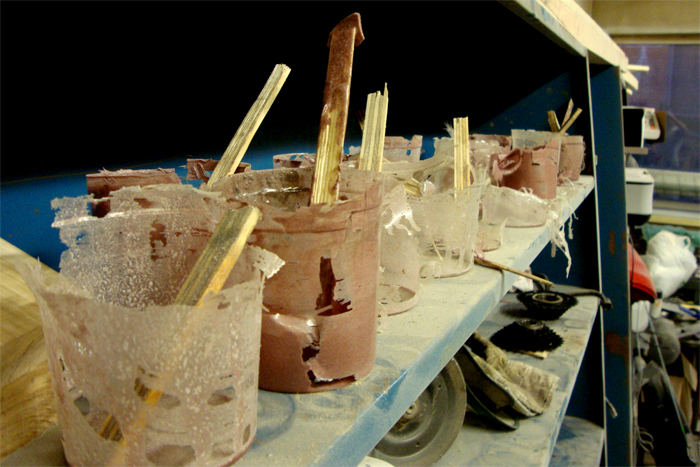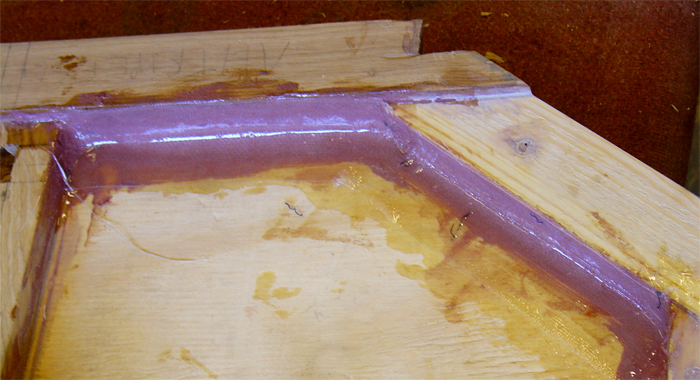Mixing epoxy
The most important aspect of mixing is the ratio of resin to hardener. Usually the recommended ratio is given by the producer, as is for our own glue. For the West System 105 resin and 207 hardener it is 1:5. In the long run you definitely want some pumping system that enables you to achieve this ratio automatically. Firstly it saves time, secondly glue and most importantly – money. Investing into dispensing pumps is very much worth the value. Of course you still need to mix the mixture to acquire a homogeneous mix. This is also true when you add some filler to the base mixture. When adding filler, extra care needs to be taken that all chunks of filler material get mixed, these will otherwise leave a weak spot into the work.
Mixing tools
What we use to mix epoxy are little plastic jam jars, maybe the size of a coffee cup. They are elastic and yet rigid enough to stand the strains of mixing larger amounts of dense filler mixture. We tried with thin plastic drinking cups, but they break when mixing anything denser than a base mixture of resin and hardener. I personally dislike them, because even when mixing clear resign it feels like you are holding something paper. Not solid enough. Besides, the jam jars are reusable. You can just crunch the dried epoxy out, no problem. use a stick to get the little dried buggers off the wall of the cup and you are all set. Maybe you can buy these in larger quantities from some producer or home appliance store, I bet you can. I got ours from my mother who eats the right kind of jam.

Here you see a shelf full of dried and released jam-cup sessions. The sticks are in there solid. This form easily pulls out of the jam cup, making cleaning easy.
Mixing sticks are always missing when you need them. I recommend making many and setting them aside for later use. Depends really how elaborate you want to be. What we have done is cut long strips of wood with a saw and then split them into sticks. Works good. When mixing a dense filler mixture it is good to have a sturdy stick at hand (think left at will).
Plus, you always want to wear gloves when dealing with epoxy. This glue has such volatile moods. If there is the remotest possibility of it landing somewhere where you do not want it to – conciser it already landed. Take the time to wear gloves, change your daily clothes for working clothes, wear a hat, protection goggles, the full load of protective equipment. Epoxy is very toxic!
Mixing very large patches of epoxy could be done with a mixing bit and a drill, but we have not yet had the need for such work.
Applying epoxy
a) Laminating – for laminating it is best to estimate the amount of epoxy you need, prepare it, coat both surfaces and press together with not too much force. You want to see some resin dripping from the joint, this means that all space has been filled in the laminate. Do this when the working surfaces are horizontal, it will give best results. Vertical lamination is also possible, but then the application of the glue will be difficult. Apply the glue with a spatula. Best if you use a glue-comb. These give you a even coat all across the surface, which is important. We use straight edges spatulas, which are better for applying glass. Another option is to use cheap paint rolls. These will suck up some glue, but when coating large areas they are very beneficial, especially for clear coating. Be sure that the mating surfaces are smooth. Uneven surfaces will gulp more glue and leave a worse joint in comparison. When epoxying large surfaces we mix the glue into a cup and then pour the lot onto the surface, eg. when applying glass, then spread it around with the spatula. Be generous with the glue, not too much, but you want to see some glue dripping from the compressed joint, as mentioned above. This applies to all of the following descriptions.
b) Jointing – depends on the surface area. If you are scarfing large surface areas, then refer to the methods above. When jointing smaller surfaces, then we have used a stick to scoop the mixture out of the mixing jar onto the surface and then used the same stick to spread it around. It is good to mark down the area onto which you need to apply the glue with a pencil, for example when applying reinforcing bars to plywood bulkheads. Place the bar on the bulkhead, trace it out, apply the glue onto both surfaces in the right place and apply pressure. This will waste less glue.
End grain of any wood will take more glue than the surface cut in line with the fiber. Precoat these surfaces twice before compressing. If the surfaces are uneven and are hard to smooth, then add slight filler to your glue to make it denser. This will ensure a better joint. What is actually recommended as a standard procedure by the Gougeon brothers is that you coat both surfaces with a clear coat before applying glue, then add the “working layer” which will have some filler in it. This will give the strongest joint.
c) Filleting – is a heavenly fun. This is best done when you have prepared a generous amount of corners to fillet. We use a method recommended by Doug Jackson from www.svseeker.com. Obtain some strong plastic bags with clear no-fold corners. Folded corners also work. Cut a sealed corner off the bag so that it forms a cone. Put the fillet mixture into the cone, wrap it up from the end like a candy and cut a hole into the tip of the bag. Then apply the filler to the corners you need. The size of the hole you cut determines the speed of releasing the glue. This is a good method when you need to apply long fillets. Smooth out the rough fillet with a suitable radius round plastic scraper. We cut ours from the lids of the jam jars mentioned above – very good to have. If you plan on glassing the fillet, then we recommend applying the glass tape immediately after filleting. The tape will adhere to the fillet and you can do some additional smoothing as the tape will make a nice slippery surface to level with your gloved finger. Then apply a clear coat to the glass to soak it trough. The glass has to become see trough unless you are using Kevlar, carbon fiber or the like. A friend of ours used the method of actually applying the filler to the tape and then applying the filleted tape to the corners. This will also work, depends on the situation. We use cheap brushes to apply the clear coat to fillets. We cut the length of the brush down to about 2/3 so that it becomes more rigid and enables more of a forced coating action. This will save you glue, believe it or not. Try to buy these brushes in bulk, if possible. We found some that cost under 1 €.

Here you see a fillet applied as described above. First the purple fillet mixture was added to the corner, then roughly rounded with the round scraper and then the tape was added, tapped into place after which a clearcoat was applied.
Fillers
Fillers come in a variety. Too abundant of a variety to do an overwhelming description of them all with our limited knowledge of the matter. We bought a low density filler from West System, they call it microbubbles I think. When dried, this leaves a fillet which is easily sanded down. Depends really on how much you add filler. The denser the mix, the easier the sanding with this low density filler. Later, when we ran out of this low density filler, we started filleting with a mixture of little glass microbubbles and fine cotton dust. Cotton dust actually makes epoxy harder. A cotton based filler fillet will be very hard to sand, it will be very strong. On the other hand, all-glass fillets are very-very easy to sand. So it really depends on the application of the fillet to determine the contents of the mix, using both at the same time is no problem. We have experimented with wood dust left from sanding. This is good for glass-filleting, but not for smoothing out surfaces, because the fibers form chunks and it will be hard to smooth out. When you apply a glass tape to the wood-dust fillet, then the uneven surface of the fillet will not be a problem, since you can smooth it out once the tape is on, as described above. Wood dust filler left a very hard fillet as well. A pain to sand, but definitely cheap.
Additional comments
1) Looking at the Volvo Ocean Race videos i once saw mechanics repairing one of the yachts in a cold shipyard. They used blow driers to warm up the epoxy to make it run better. I had read about this forehand as well. Since epoxy is a polymer based glue (it forms a plastic) heat stretches the molecular connections and makes the glue flow better. We used the blow drier to help soak very thick glass, which took ages otherwise. You can also soften solid epoxy with heat. Heating up curing epoxy is not something which is recommended but we have seen it work. This is an SOS alternative, which will leave a weaker joint and we can give no guarantee for no-failure.
2) Oak is not as easy to epoxy as fir or pine since it is slightly acidic and very dense. What is recommended is to use a clear mixture on rough-sanded surfaces (what we have done) to pre-soak the maters. Then apply a coat of glue with slight filler content.
3) Always use a dust mask when sanding dried epoxy. You will otherwise develop allergies over time. Try to cover any exposed body parts, it is seriously harmful stuff.


Tere,
Lugesin suve lõpul huviga teie blogi läbi ja sain palju uut ja kasulikku infot aga samuti inspiratsiooni ise üks väiksem vineerpaadi ehitus ette võtta. Tänaseks on joonised laual, raamat paadiehituse kohta tellitud ja materjalikalkulatsioonid tehtud. Üllatavalt kallis tuleb, tootjatelt saaks uue paadi sarnase hinnaga :). Kuid eks see ole ikka nii, et hobi eest tulebki maksta. Vähemalt ei ole vaja kogu raha kohe välja käia ja pealegi on saadav kogemus kindlasti seda kõike väärt.
Tahtsin küsida, et ega te oma otsingute käigus ei leidnud veel mõnda paadiehituseks sobivat pinda? Ega teil ei ole äkki seal oma ruumides ruumi kaasüürilisele? Kuidas muidu tööga läheb, ega ära ei ole tüüdanud so kas epovaigu kasutate ikka ise ära või tahate maha ärida :). Nali naljaks, ajaliselt pikad projektid võivad nii mõningaidki muutusi plaanidesse tuua. Ise olen oma paadiehituse kinnisideega suht hädas, tuhin ei taha üle minna. Olen võtnud eesmärgiks suve alguseks veepeale saada, kuid eks aeg näitab kas õnnestub või mitte.
Jõudu soovides,
Linnar
Tere!
Millist paati täpsemalt sa ehitada kavatsed? Muidu nii ta on jah industriaalühiskonnas, et ostes uuena saad odavamalt, kui ise tehes. Samas jääd ilma isetegemise lõbust ja valust, samuti pead leppima sellega, mida sulle müüa tahetakse. Mina ei kahetse, et oleme isetegemise tee ette võtnud, nimelt raha paadi jaoks kokku ajada pole niivõrd põnev, kui paati ise teha.
Pinnaküsimus oli meilgi esimeseks suureks blokiks. Praegu on nii, et ehitame motomeeste/tehnikute garaažis, ja kardan, et nad väga rõõmsa meelega veel üht tolmutajat sinna ei taluks. Juba meilgi on tegu, et mitte väga jalgu jääda. Loodame ehitusega lõpliku aja jooksul valmis saada siiski, et jalust ära kolida. Tegelikult on see mõte juba läbi välja pakutud Raivo Luige poolt, et kui on huvilisi, siis võib ära tasuda suurema ühise tööpinna hankimine mitme inimese peale, midagi n-ö meeste varjupaiga laadset.
Tööga läheb meil jõudsalt, oluliselt jõudsamalt kui blogi kirjutamisega. Viimaseks peaks vist palkama mingisuguse avalike suhete eksperdi 😀 Tegeleme siseviimistlusega, mille põhiosa on pindade epotamine-klaasimine ning meie epotünn saab varsti tühjaks ning oleme Bang&Bonsomerist uut tellimas. Ajaplaane, kuna valmis kavatseme saada, ei tee, arvestame hetkel nädala kaupa, kuna põhitöö ja füüsikaõpingute kõrvalt aja leidmine on küllalt keeruline.
Jõudu sulle ehituseks ja edu kohaotsinguil. Kui jõuad puutööni, siis oleks tore vaatama tulla.
Tervitustega
Joosep
Tänan vastuse eest!
Teen Dudley Dix Challenger 13 paadi ja hetkel vaagin erinevaid materjale. Minuni on jõudnud raamat “How to Build Glued-Lapstrake Wooden Boats”, kus väidetakse, et kui paati ei hoita kogu aeg vees, siis ei ole pindade epotamine vajalik eeldusel, et ehituseks kasutatakse kvaliteetset (sertifitseeritud) merevineeri. Minu jaoks uus info, uurin variante, ehk piisab ühenduskohtade ja täävide lamineerimisest (nii seest kui väljast).
Tervitades
Tere!
Sertifitseeritud merevineeri puhul ei ole tingimata ka meie purjeka autori kohaselt lausepotus vajalik. Merevineer ei delamineeru veekeskonnas (esimeste aastatega). Ent mingi kaitse on elementaarne, sest tegemist on ikkagi orgaanilise materjaliga ning selle peale on igasugu elajad maiad. Teiseks on hea purjeka põhja erinevate marrastuste eest kaitsta, selleks on klaasriie väga sobilik. Svertpaadiga on ju lust svert üles tõmmata ja otse rannaliivale põrutada. Painutaks Sa pardad kuuselaudadest, siis oleks teine lugu. Ühenduskohad tuleks vineer-klinker/karaveel plangutuse puhul kindlasti klaasteibi ja epotäidisega katta (nagu ilmselt ka Sinu raamatus kirjas on). Mina soovitan, kui juba sedavõrd ilusa väikse purjeka ehitamiseks läheb, paadi välispind klaasida. Meie ehitus on teist laadi. Katame paadi nii seest kui väljast epoga. Sees päris kõiki pindasid klaasida ei ole plaanis, ent kindlasti epoga katta. Põhjuseks on odavam vineer, mis on maias delamineeruja. Meie keetmiskatsed seda ei näidanud, ent kogemus elust enesest näitab, et vee ja päikse käes vineer tõepoolest laguneb. Meil on vineer nn. ruumitäidiseks kahe epokihi vahel, umbes nagu kipsplaat. Teisalt kulub seetõttu rohkem epot. Esialgu ilmselt kokku 60+ kg. Mainitud kaks ehitusviisi ei ole komplementaarsed, mõlemil plussid ja miinused. Selget vastust ei oskagi anda (on see üldse võimalik?). Sõltub, mida tulevase veesõidukiga plaanis teha on. Oled Sa varem paati ehitanud? Meie üks põhjendusi odavama vineeri valikul oli, et kuna varasem paadiehituse kogemus puudus, siis raiskame nii või teisiti rohkem vineeri (oleme juba plaanides määratud kogusest mõned plaadid rohkem ostnud). Merevineeri puhul kujutan ette, et iga plaadi kasutus tuleks hoolikalt läbi mõelda, vahest isegi arvutis mingi pindjaotus teha. Abiks võib olla järgnev video: http://www.youtube.com/watch?v=_ymEoivrrK0 Videos testitud vineerist ehitati allveelaev. Nüüd tegelb vanapaar 24 m teraspurjeka ehitamisega.
Head,
Uku
Tere,
kas oskaksite öelda, kus võib Eestis olla parim valik epoxy kraami müügil?
Tänud,
Mait
Tere!
Ausalt öeldes ei oska sellele küsimusele ühest vastust anda. Meie ostsime oma West Systemi EPO Eesti tütarfirmast Bang & Bonsomer. Vailsime West Systemi, sest seda soovitas meile hea sõber, kes sellega ise paate on ehitanud. Lisaks on liimil paadiehitajate seas hea kuulsus ja pikk ajalugu. Ilmselt ei ole tegemist kõige odavama tootega. EPOsid on mitmesuguseid, valik sõltub kasutamiseesmärgist. Sellest tuleks ka lähtuda ja siis, kahjuks, googeldada 🙂 Meie saime oma epojahil sageli soovitusi, et helistaksime laevatöökodadesse, et kas need oleksid oma tagavaradest nõus müüma. See on üks variant. Lisaks tarnivad epovaike igasugu autofirmad. Samas ehitatakse Tartus Emajõe ääres kiirpaate veel nõuka-ajast üle jäänud liimidega. Vastus on jah, kahjuks kirju ja napp!
Jõudu sellegipoolest,
Uku